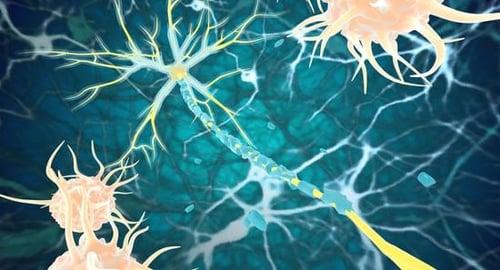Understanding Nerve Pain in the Lower Leg: 6 Common Causes Explained

Lower leg pain is a prevalent issue experienced by many individuals, and it can have various causes, ranging from minor overuse to more serious underlying conditions.
While some degree of leg soreness after exercise or physical activity is normal, persistent, or recurring nerve pain requires a consultation with your healthcare professional for proper evaluation and diagnosis.
“Pain starts in receptor nerve cells found beneath the skin and in organs throughout the body. When you are sick, injured, or have other types of problems, these receptor cells send messages along the nerve pathway to the spinal cord, which then carries the message to the brain,” explains John Hopkins Medicine.
“Chronic pain is one of the most costly health problems in the U.S. Increased medical expenses, lost income, lost productivity, compensation payments, and legal charges are some of the economic consequences of chronic pain.”
Nerve pain, called neuralgia, is characterized by a feeling like shooting, stabbing, tingling, or burning sensation. It is caused by damage or injury to the nerves that send messages to your brain to signal pain.
How Common is Lower Leg Pain in the U.S.?
Lower leg pain is a relatively common problem in the United States, affecting people of all ages and activity levels. From athletes and active individuals to those leading more sedentary lifestyles, many may experience leg pain at some point in their lives.
A study published more than a decade ago found that almost 16 million Americans suffer from chronic neuropathic pain.
A medical textbook archived last year by the National Library of Medicine
While most cases are benign and resolve themselves with self-care, persistent or severe pain may indicate an underlying issue that requires medical attention.
“Peripheral neuropathy can be a manifestation of a wide range of pathologies that require further evaluation and/or treatment,” wrote Claudia Hammi and Brent Yeung in Neuropathy
Nerve Pain vs. Normal Soreness in the Lower Legs
In many instances, lower leg pain is not serious and can be attributed to overexertion, muscle strain, or minor injuries that improve with rest and home remedies. However, some cases of lower leg pain can be more concerning, especially if they are accompanied by certain symptoms like:
- Numbness
- Weakness
- Swelling
- Difficulty walking
Any persistent or worsening pain that hinders daily activities should be evaluated by a healthcare professional to determine the root cause and appropriate treatment.
Keep in mind that nerve pain, often described as shooting, burning, or electric-like sensations, differs from normal soreness or muscle aches in the lower legs.
How to tell the difference between normal soreness in your lower legs and nerve pain? Here’s the difference between the two:
- Normal soreness, also known as delayed onset muscle soreness (DOMS), typically occurs after engaging in new or strenuous physical activities and is caused by tiny muscle tears that heal over time.
- On the other hand, nerve pain results from irritation or damage to the nerves responsible for transmitting signals between the legs and the brain. Nerve pain can be chronic and may require specific treatments depending on its cause.
6 Causes of Lower Leg Nerve Pain Explained
There can be many explanations for the cause of lower leg nerve pain but here are 6 conditions that can cause it along with the cause, symptoms, and treatment options:
- Peripheral Neuropathy:
Cause: Peripheral neuropathy refers to nerve damage in the peripheral nervous system, which includes the nerves outside the brain and spinal cord. Diabetes is a common cause of peripheral neuropathy, but it can also result from alcohol abuse, certain medications and toxins, infections, tumors, vitamin and nutrient deficiencies, autoimmune and inflammatory conditions, genetic conditions, vascular disorders, trauma and surgery, and other medical conditions.
Symptoms: Symptoms include tingling, numbness, weakness, and burning or stabbing pain in the lower legs. The pain may worsen at night.
Treatment: Treatment aims to address the underlying cause and manage symptoms. Medications, physical therapy, and lifestyle changes are often part of the treatment plan. - Sciatica:
Cause: Sciatica occurs when the sciatic nerve, which runs from the lower back through the hips and down each leg, becomes compressed or irritated. This compression is commonly caused by a herniated disc in the spine, degenerative disc disease, or spinal stenosis (narrowing) of the lumbar spine. Sciatica is also known as lumbar radiculopathy or referred to as a “pinched nerve.”
Symptoms: Pain in the lower back that radiates down the leg, often to the foot. The pain may be accompanied by tingling or numbness. Some patients may experience weakness when bending the knee, difficulty bending the foot inward or down, difficulty walking on their toes, difficulty bending forward or backward, and abnormal or weak reflexes.
Treatment: Rest, gentle stretching, and over-the-counter pain medications may help alleviate mild cases. Severe or persistent cases may require physical therapy or corticosteroid injections. Surgery to relieve the compression of the spinal nerves is usually the last resort for treatment. - Tarsal Tunnel Syndrome (TSS):
Cause: Like carpal tunnel syndrome (TSS) in the wrist, tarsal tunnel syndrome involves compression of the posterior tibial nerve as it travels through the tarsal tunnel of the ankle (located on the inside of the ankle and is formed by the ankle bones and the band of ligaments that stretches across the foot). Causes of TSS can include flat feet or fallen arches, swelling caused by an ankle sprain, diseases such as arthritis or diabetes, varicose veins, ganglion cysts, swollen tendons, or bone spurs.
Symptoms: Pain, tingling, and burning sensations in the ankle, foot, and toes. Symptoms may worsen with prolonged standing or walking.
Treatment: Rest, icing, and immobilization of the foot can help. Anti-inflammatory medications or steroid injections into the tarsal tunnel to relieve pressure and swelling may be given. Physical therapy and orthotic devices may be recommended in severe cases. Podiatrists who specialize in foot and ankle surgery may recommend an operation called a tarsal tunnel release, during which the surgeon creates an opening behind the ankle that extends down to the arch of the foot and divides the ligament, so it is not pressing against the tibial nerve - Peripheral Artery Disease (PAD):
Cause: Peripheral Artery Disease (PAD) is a circulatory problem where narrowed or blocked arteries reduce blood flow to the legs and feet. It is primarily caused by the buildup of fatty plaque in the arteries, which is called atherosclerosis. PAD can happen in any blood vessel, but it is more common in the legs than the arms.
Symptoms: Leg pain, cramping, or fatigue during exercise or walking. The pain often subsides with rest. Physical signs in the leg that may indicate PAD include muscle atrophy (weakness); hair loss; smooth, shiny skin; skin that is cool to the touch, especially if accompanied by pain while walking (that is relieved by stopping walking); decreased or absent pulses in the feet; sores or ulcers in the legs or feet that don’t heal; and cold or numb toes.
Treatment: Lifestyle changes, such as quitting smoking and regular exercise, are essential in managing PAD. Medications to improve blood flow and, in severe cases, surgical interventions to bypass blocked arteries may be recommended. - Compartment Syndrome:
Cause: Compartment syndrome is a painful condition that occurs when pressure within the muscles builds to dangerous levels. This pressure can decrease blood flow, which prevents nourishment and oxygen from reaching nerve and muscle cells. Compartment syndrome can be either acute (having severe symptoms for a short period of time) or chronic (long-lasting). Acute compartment syndrome is a medical emergency. It is usually caused by severe injuries such as fractures, badly bruised muscles, and crush injuries and is extremely painful. Without treatment, it can lead to permanent muscle damage.
Symptoms: Acute compartment syndrome pain is more intense than what would be expected from the injury itself. Using or stretching the involved muscles increases the pain. There may also be tingling or burning sensations (paresthesia) in the skin. The muscle may feel tight or full. Chronic compartment syndrome symptoms include numbness, difficulty moving the foot, sometimes with the sense of the foot slapping downward when running, or visible muscle bulging.
Treatment: Acute compartment syndrome is a medical emergency and requires immediate surgical intervention to relieve the pressure. Go to an emergency room immediately if there is concern about acute compartment syndrome. For chronic compartment syndrome, treatment can include physical therapy, orthotics, and anti-inflammatory medicines. If conservative measures fail, surgery by a foot and ankle specialist may be an option. - Morton's Neuroma:
Cause: Morton's neuroma is a thickening of tissue around a nerve between the toes, commonly between the third and fourth toes. Also known as interdigital neuroma, Morton metatarsalgia, interdigital neuritis, or a plantar neuroma. Morton’s neuromas are around 8 times more common in women than men and typically affect people between the ages of 30 and 60, though they can occur outside of this age range as well.
Symptoms: Pain, burning, or a sensation of stepping on a pebble in the ball of the foot or between the toes. Others describe it as “walking on a marble” or persistent pain in the ball of the foot (forefoot). There may be numbness or an unpleasant tingling in the toes.
Treatment: Wearing roomy footwear (avoiding high heels and tight, narrow shoes), using orthotic devices (such as custom inserts), and corticosteroid injections may help relieve symptoms. Severe cases may require surgery to remove the diseased portion of the nerve or release tissue around the nerve.
Lower leg pain is a widespread issue that can result from various causes. While some cases may resolve with rest and self-care, persistent or severe nerve pain requires proper evaluation and treatment by a healthcare professional.
If you have persistent or recurring lower leg nerve pain, schedule a consultation today with the board-certified surgeons with Sweeney Foot and Ankle Specialists to examine the causes of your pain and your treatment options.






